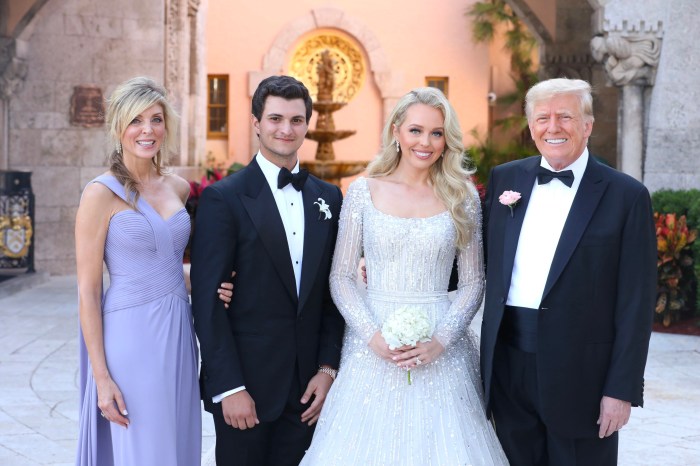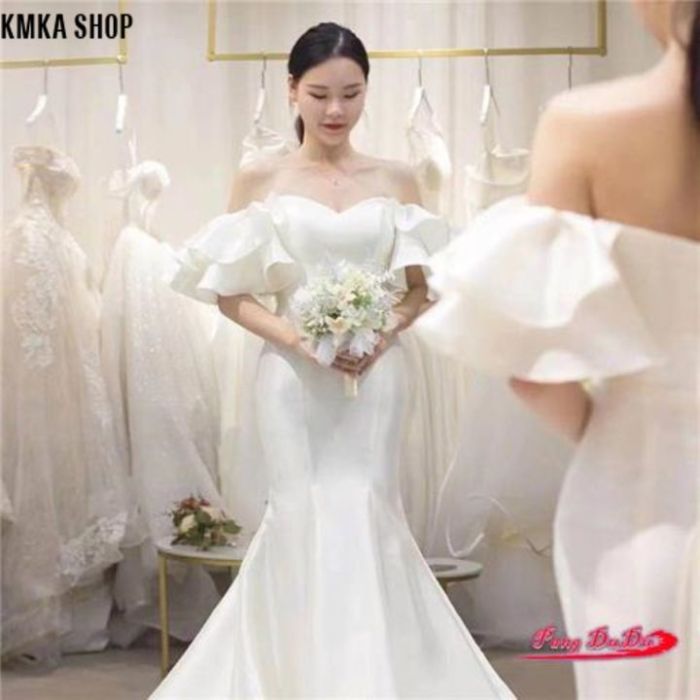Wedding Guest Attire Etiquette
White dress at a wedding – Navigating wedding guest attire can be tricky, but understanding the unwritten rules ensures you celebrate the couple without overshadowing them. This section will clarify traditional etiquette, address exceptions, and offer guidance for various wedding styles.
Traditional Wedding Guest Attire Rules
Traditionally, wedding guests avoid wearing white, as it’s reserved for the bride. Bright, bold colors are generally discouraged, as are overly casual attire like jeans or t-shirts. The dress code, if specified by the couple, should be strictly followed. Guests should aim for attire that is respectful, elegant, and appropriate for the venue and time of day.
Exceptions to Traditional Rules

Source: footwearnews.com
While tradition dictates certain guidelines, exceptions exist. Informal weddings, such as beach weddings or backyard ceremonies, often allow for more relaxed attire. Themed weddings may also call for specific attire, which should be clearly communicated on the invitation or wedding website. Children are often exempt from strict dress code adherence.
Appropriate and Inappropriate Attire Examples
Appropriate attire might include a cocktail dress, a pantsuit, or a stylish jumpsuit for women, and a suit or sport coat and dress pants for men. Inappropriate choices would be anything too revealing, overly casual (like jeans and a t-shirt), or attire that closely resembles the bride’s dress, especially in color and style.
Appropriate Attire for Different Wedding Settings
| Venue Type | Dress Code | Appropriate Attire | Inappropriate Attire |
|---|---|---|---|
| Beach Wedding | Casual/Semi-Formal | Flowy maxi dress, linen pantsuit, light-colored suit | Jeans, shorts, swimwear (unless specifically stated) |
| Church Wedding | Formal | Floor-length gown, elegant suit, cocktail dress | Mini dresses, jeans, casual sneakers |
| Ballroom Wedding | Black Tie/Formal | Floor-length gown, tuxedo, elegant suit | Casual dresses, jeans, sneakers |
| Garden Wedding | Semi-Formal | Midi dress, jumpsuit, tailored suit | Beachwear, overly casual attire |
The Significance of White at Weddings

Source: lazcdn.com
The association of white with weddings, and specifically the bride, is rooted in history and culture. This section explores the reasons behind this tradition and the implications of guests wearing white.
The classic white dress at a wedding often symbolizes purity and joy. However, the decision of what to wear can be complex, especially when considering ethical and sustainable choices. For brides seeking a domestically produced gown, exploring options like those found at wedding dresses made in usa ensures quality and supports American craftsmanship. Ultimately, finding the perfect white dress, regardless of origin, is key to a memorable wedding day.
Cultural and Historical Reasons for White
The tradition of the bride wearing white began in the Victorian era, symbolizing purity and innocence. Before then, brides wore their finest clothes, regardless of color. Queen Victoria’s choice of a white gown for her wedding in 1840 popularized the trend, and it has since become a global symbol of bridal attire.
Social Implications of Guests Wearing White
Wearing white to a wedding can be perceived as attempting to upstage the bride. It’s a significant breach of etiquette and can cause offense to the bride and groom. The level of offense depends on the context, including the style of the white garment and the overall wedding atmosphere.
Acceptable Exceptions for White Dresses
Exceptions might include a very young child in a white dress, or in certain cultural contexts where white holds different symbolic meanings. However, these situations are rare, and caution should always be exercised.
Symbolism of White in Different Cultures
While white often symbolizes purity and innocence in Western cultures, it can represent mourning in some Asian cultures. In other cultures, white may symbolize joy, celebration, or even spirituality. Therefore, understanding the cultural context is crucial when considering wearing white to a wedding.
Alternatives to a White Dress for a Wedding Guest: White Dress At A Wedding
Choosing a stunning outfit that respects the occasion is key. This section provides guidance on selecting appropriate colors, fabrics, and accessories.
Alternative Dress Colors and Styles
Numerous elegant alternatives to white exist. Pastel shades, jewel tones, and bold colors all make stylish choices. Consider a midi dress, a jumpsuit, or a skirt and top combination. The style should be appropriate for the venue and dress code.
Appropriate Fabrics and Textures
Linen and cotton are suitable for summer weddings, while velvet or heavier fabrics are more appropriate for winter events. The fabric’s texture should complement the overall style of the outfit and the season.
Accessory Suggestions
Accessories can elevate any outfit. Consider a statement necklace, elegant earrings, a stylish clutch, or a sophisticated hat. Choose accessories that complement the color and style of your dress without overpowering it.
Creating a Visually Appealing Outfit
Imagine an outfit based on a wedding with a blush pink and gold color scheme. A guest could wear a dusty rose-colored midi dress with delicate lace detailing. Gold heels, a gold clutch, and subtle gold jewelry would complete the look. The overall style would be elegant, romantic, and perfectly complements the wedding’s color palette without clashing.
Addressing a Potential Wardrobe Misunderstanding
Dealing with a guest in a white dress requires tact and diplomacy. This section provides strategies for addressing the situation effectively.
Strategies for Addressing a Guest in a White Dress
A private and gentle conversation is essential. Avoid public confrontation. Focus on the potential for misinterpretation rather than direct criticism. Offer suggestions for alternative attire if possible.
Potential Consequences of Ignoring the Issue
Ignoring the situation can create tension and discomfort for the bride and groom. It could lead to awkwardness throughout the wedding and negatively impact the couple’s special day.
Approaching the Situation with Empathy and Tact
Empathy and understanding are crucial. The guest may not have realized the implications of their attire. A calm and respectful conversation is more likely to yield a positive outcome.
Sample Conversation Script, White dress at a wedding
“Hi [Guest’s Name], I hope you’re having a wonderful time getting ready for the wedding! I wanted to chat briefly about your dress. We’ve noticed it’s white, and we just wanted to gently suggest perhaps changing into something else, as white is traditionally associated with the bride. We don’t want anything to take away from [Bride’s Name]’s special day. We understand it might have been an oversight, and we truly appreciate your understanding.”
“[Guest’s Response]”
“That’s perfectly fine! We appreciate you being so understanding. We have some extra time before the ceremony, so hopefully you’ll be able to find something else. Let me know if there’s anything I can do to help.”
Visual Representations of Appropriate and Inappropriate Wedding Guest Attire
Visual descriptions of appropriate and inappropriate outfits provide further clarity on acceptable wedding guest attire.
Appropriate Wedding Guest Outfit
Imagine a sophisticated navy blue midi dress with a flattering A-line silhouette and three-quarter sleeves. The fabric is a luxurious crepe, and the dress features a subtle V-neckline. Paired with nude-colored heeled sandals and a delicate silver necklace, the overall style is chic and elegant, perfect for a semi-formal wedding. A small, structured clutch adds a touch of sophistication.
Inappropriate Wedding Guest Outfit
Consider a short, white mini-dress with a low neckline and excessive embellishments. The fabric is thin and revealing, and the dress is paired with strappy high heels and a large, flashy necklace. The overall style is attention-grabbing and inappropriate for a wedding, particularly given the white color and revealing nature of the dress.
Visual Impact of Dress Lengths and Necklines
Longer dress lengths, such as midi or maxi dresses, generally convey more respect and formality. Higher necklines, such as bateau or crew necks, tend to be more appropriate for formal settings than low-cut necklines. The combination of dress length and neckline significantly impacts the overall appropriateness of the outfit.
Expert Answers
What if the wedding is on the beach and a white dress feels appropriate?
Opt for a white dress that is clearly different from a bridal gown – consider a different fabric, silhouette, or embellishments. A breezy, flowing white dress might be acceptable for a casual beach wedding, but avoid anything that resembles a wedding dress.
Is it okay to wear off-white or cream to a wedding?
It’s generally safer to avoid shades that are too close to white. Opt for a noticeably different color, such as ivory, beige, or champagne.
What if a child is wearing a white dress?
Young children are typically exempt from this rule. However, it’s still considerate to ensure the dress is not overly formal or bridal-like.
How do I politely address a guest wearing a white dress?
Speak privately and with empathy. Express your concern gently, focusing on the potential for misinterpretation rather than directly criticizing their choice. Offer a solution, such as suggesting they might feel more comfortable in a different outfit for future events.
